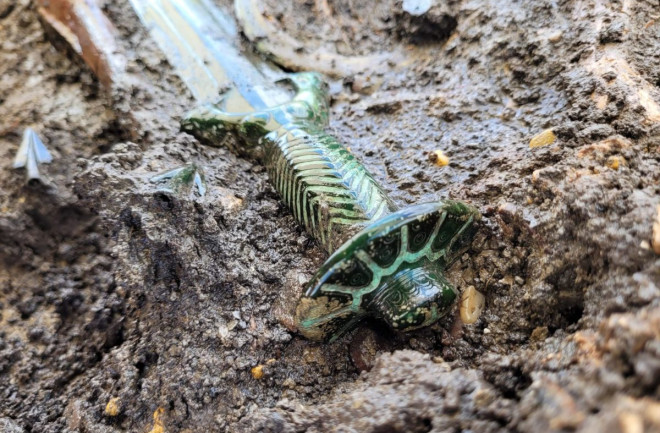Often, when archaeologists dig up an artifact that's thousands of years old, it requires some imagination to picture what it might have looked like back then. That certainly wasn't the case for a team of scientists who peered into a gravesite in southern Bavaria.
In 2023, archaeologists in Germany unearthed a Bronze Age grave containing a 3,000-year-old sword that’s so extraordinarily well-preserved that it "almost still shines," says Bavaria's State Office for Monument Protection in a statement, according to Google Translate.
Discovered in Nördlingen, in the Donau-Ries region of Germany, archaeologists hope the remarkable find can offer a glimmer into Bronze Age life.
How Old Is this Bronze Age Sword?
Johann Friedrich Tolksdorf, an archaeologist with the Bavarian State Office for the Preservation of Monuments, explained that the grave site (and the sword itself) date back to the 13th or 14th century B.C.E.. Discoveries of this kind are rare, he explained, as most known burial mounds were already excavated in the 19th century.
Read More: From Stone Tools to Guns: A Timeline of Ancient Weapons
Archaeologists unearthed a man, woman, and a youth within the grave, and it’s believed they were not all buried at the same time. “We don't know if they were related biologically or if there are social bonds between these persons,” Tolksdorf says.
What Else Did the Scientists Find?
Alongside the sword, Tolksdorf and his team discovered ceramics and other bronze objects such as arrowheads, a belt that was possibly part of a scabbard, and balled up wires that “were probably attached to textiles.”
Excavation of the grave took place beside a river on a floodplain, and it’s thought that a layer of silt must have quickly covered the site, creating conditions for the bronze objects to remain remarkably well-preserved.
Unfortunately for the researchers, though the bronze stood the test of time, the bones and other materials didn’t fair so well.
“It seems that what was good for the bronze objects was rather bad for the bones,” Tolksdorf says. Their poor state of preservation may frustrate efforts to extract DNA for analysis that could help identify their relation to one another, but the team remains hopeful.
How Were Swords Used in the Bronze Age?
Curiously, the sword — which is octagonal in design — bore no marks indicating it was ever used in combat. Specialized craftsmen from either Southern, Northern Germany, or Denmark may have crafted it.
Read More: 5 of the Most Unique and Luxurious Bronze Age Artifacts
“The occurrence of swords with similar design and decoration suggest the presence of specialised craftsmen, although their specific working environment and their relationship to the customer are still poorly understood,” Tolksdorf says.
Carrying a sword of this kind in the Bronze Age was not just for ceremonial purposes but rather a statement of social, economic, and possibly political status, he adds. It’s likely the buried man was both wealthy for his time and a warrior.
What Do We Know About the Sword's Owner?
To better understand the unknown warrior’s position in his society, Tolksdorf points to the Bronze Age battle site of Tollense Valley, where large armies took to the field in Germany in the mid-Bronze age period.
Dating to around 1,300 to 1,250 B.C.E, this conflict appears to have centered around a wooden bridge and involved hundreds, and possibly thousands, of individuals. Alongside numerous bones showing evidence of violent deaths, archaeologists have unearthed weapons including arrowheads, clubs, spears, and swords.
This shows that “some kind of political organization” must have existed from around the 14th century BC that mobilized several hundred warriors at a time, Tolksdorf says Situating the unknown Bronze Age person buried at Nördlingen in such a context means he probably held an elevated position in his society at the time, due to his possession of such a fine weapon.
Read More: Medieval Hand Grenade Reveals Ancient Explosive Technology
“The sword seems to be some kind of weapon associated with a higher social status, as a close combat weapon,” Tolksdorf says. “Perhaps the owner of the sword was part of a culture that also relied on the organization of military campaigns.”
Though the Nördlingen swordbearer was probably not of the rank to lead hundreds of warriors in his society, it’s possible he was “one of the middlemen,” Tolksdorf says, holding something akin to “officer” rank.
What Can Scientists Learn from Studying Bronze Age Sites?
Beyond the discovery of the sword and burial goods, more may come to light as researchers apply modern technology and research methods to the site. This may include identifying the relationship between the three people in the gravesite, and uncovering what else was buried alongside them.
“His social group arranged his grave and wanted him to be arranged in a specific way as a rich person,” Tolksdorf says. “In the end it will add to the bigger picture, like the Tollense battlefield, and help us to understand Bronze Age society as a whole.”
Read More: What Evidence Is There For a "Wood Age" to Rival Those of Stone, Bronze, and Iron?

